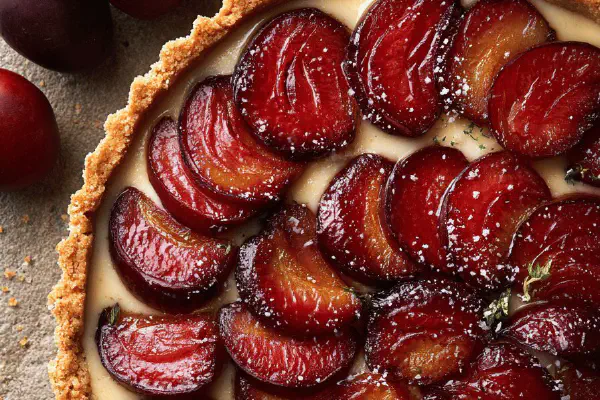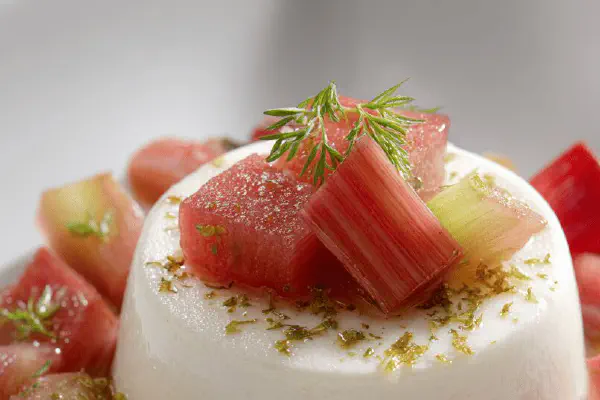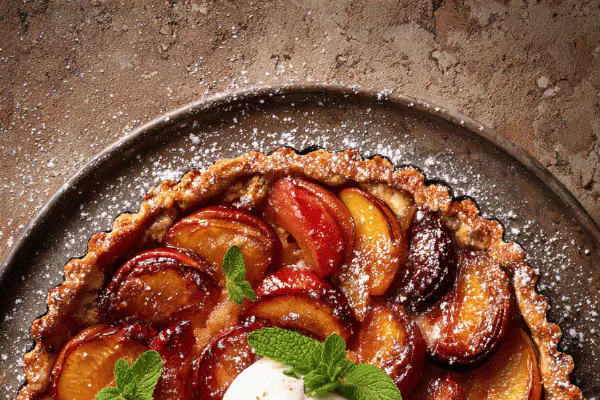Strawberry Meringue Tartlets

By Emma
Certified Culinary Professional
Ingredients
Crust
- 150 g all-purpose flour
- 25 ml powdered sugar
- 5 ml baking powder
- 1 ml fine sea salt
- 140 g cold unsalted butter, diced
- 60 ml crème fraîche (substitute yogurt)
- 20 ml ice-cold water
Filling
- 350 g hulled strawberries, sliced
- 120 g granulated sugar
- 25 ml arrowroot powder (instead of cornstarch)
- 5 ml freshly squeezed lemon juice
- 1 tsp lemon zest
Topping
- 8 fresh strawberries, thinly sliced
- 30 g crushed violet meringue cookies (store-bought or homemade)
About the ingredients
Method
Crust
- 1. Pulse flour, powdered sugar, baking powder, and salt in food processor. Add butter cubes. Pulse until mixture resembles coarse peas. Key here is cold butter chunks—not fully mixed—tiny lumps add flakiness.
- 2. Stir in crème fraîche and 20 ml ice water. Add more water by teaspoon if dough feels dry—but don't overwork. Pull dough out, press into a flattened log.
- 3. Cut into 8 equal portions. Flour surface lightly, roll each into discs about 12 cm diameter and 3 mm thick (a bit thinner than usual for a tender bite).
- 4. Fit dough into greased tartlet pans with removable bottoms (about 9-10 cm). Press edges gently, no stretching allowed or crust will shrink. Chill for at least 25 minutes to prevent shrinkage during baking. This waiting is crucial. No skipping.
Filling
- 5. Preheat oven to 195°C (385°F). Place rack in middle.
- 6. In a bowl, toss strawberries with sugar, arrowroot, lemon juice, and zest. Arrowroot gives better shine and clarity, plus slight glossy texture—different from dull starch.
- 7. Spoon fruit with all juice evenly into crusts, spreading so no lumps or crowding. Overflowing will be messy.
- 8. Bake about 30-35 minutes. Listen for gentle bubbling from the filling and watch crust edges turn golden brown with slight crisp. Darker than blond but not burned—they crisp up further out of oven.
- 9. Remove, let cool 20 min. Filling to thicken and settle; tartlets still warm but not hot is right.
Garnish
- 10. Just before serving, arrange sliced strawberries on top, scatter crushed meringues. The meringue curls and softens slightly but keeps crunch contrast.
- 11. Serve immediately or within an hour for vibrant textures. Don’t refrigerate long—crust gets soggy, meringue melts.
- 12. Leftover tartlets? Warm briefly in low oven for crispness.
Cooking tips
Chef's notes
- 💡 Chill dough thoroughly before shaping. Cold butter chunks create flakes, warm butter means dense crust. Roll slightly thinner than usual; helps balance tender filling without bulk. Watch dough texture closely—too sticky means add a touch ice water. Overkneading kills flake, so pulse or stir lightly. Dough resting 25 minutes minimum avoids shrinkage later. Grease pans well; removable bottoms ease release. Temperature right crucial; hot oven browns crust but don’t let sugar burn inside filling.
- 💡 Arrowroot powder is key; it gives shine and thickens without gumminess. Substitute with cornstarch if needed, but arrowroot holds color better and thickens at lower temps. Mix sugar and arrowroot dry before tossing with fruit to avoid clumps. Lemon zest and juice brighten flavor—leave out zest and filling dulls. Stir gently, avoid smashing berries; preserve texture. Filling bubbling gently signals done. Overbaking dries fruit, underbaking stays runny. Watch crust edges, golden with slight crisp.
- 💡 Meringue topping can be crushed store-bought cookies or homemade violet-flavored meringue. Freshness matters—crumbly but still holds crisp. Add meringue only after tarts cool slightly; melting ruins contrast. Meringue aroma hint from violet scent is subtle but noticeable in final bite. Use vanilla or almond meringue also if violet not on hand. Slicing additional strawberries for garnish gives zing and freshness; add last to avoid moisture softening crust immediately. Serve quickly after topping for best texture snaps.
- 💡 Butter temperature is a practical issue. I dice cold, then pulse fast to avoid warming. If dough looks too crumbly when adding crème fraîche and water, add liquid teaspoon by teaspoon. Dough is forgiving but don’t overwork or risk dense bite. Dough chilling can’t be skipped—had to redo batches after skipping that. Roll discs on flour-dusted surface; light flour, otherwise crust toughens. Bake on middle rack for even heat distribution; racks too high or low cause uneven browning or soggy bottoms.
- 💡 If leftovers, warm gently at low oven temp to regain crisp without remelting meringue. Refrigeration kills crunch fast; meringue melts and crust soggy. Reheat only shortly. Dough freezing possible before shaping: wrap tightly to prevent freezer burn, thaw in fridge overnight. Assemble fillings fresh after thaw. Watch filling bubbling cues again for doneness after reheating. Don’t overbake reheated tartlets; leftovers meant for immediate enjoyment or quick warm-up only.
Common questions
How to avoid crust shrinking?
Chill dough well before baking. Press edges gently, don’t stretch dough in pans. Cold dough keeps shape. Avoid overly hot oven start; allows gluten to relax. Also, flour surface lightly when rolling. Rest at least 25 min in fridge.
Can I substitute arrowroot powder?
Cornstarch works but less glossy finish. Potato starch thickens too but changes texture. Arrowroot preferred for clarity and shine. Adjust quantities—less powder for cornstarch. Always mix with sugar before fruit for even coating.
Meringue topping soggy after baking?
Add meringue only after cooling tart. Heat melts meringue. Cool 20 min minimum at room temp before topping. Store away from fridge to keep crunch. For longer hold, make meringue thicker or bake cookies separately then crush.
Best way to store leftover tartlets?
Avoid fridge if possible; crust gets soggy. Store loosely covered at room temp up to an hour. For longer, remove meringue, refrigerate base separately. Warm briefly in low oven before serving. Freeze crust dough before baking, not whole tart. Don't combine storage methods carelessly; textures break down fast.



